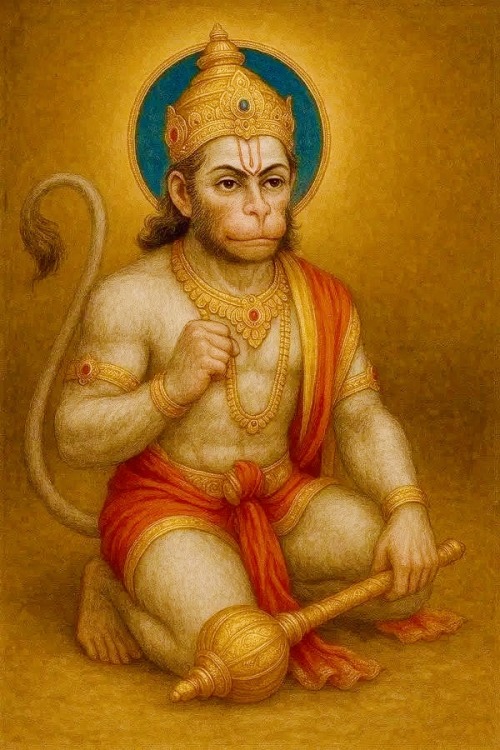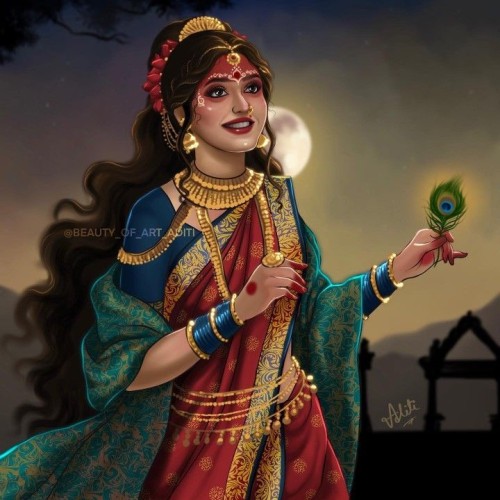बड़का मंगर / बड़ा मंगल
बड़का मंगर / बड़ा मंगल

Tuesdays (मंगर in Awadhi) falling in the month of Jyestha (जेठ या ज्येष्ठ ) are celebrated as बड़का मंगर
This is similar to how we do Saawan somvaar on Mondays in Shravan.
Devotees of Ramdoot Bajrangbali Hanuman fast (optional) each Tuesday and visit a Hanuman temple. The folktales speak of Shri Ram and Lakshman meeting Hanuman and Sugreev in the month of Jyestha.

|| जय सिया राम ||
|| जय हनुमान ||
More Posts from Hamaarmaati and Others
श्री माता वैष्णो देवी मंदिर के दर्शन
Visit to Shri Mata Vaishno Devi temple

We took a train from New Delhi to Jammu Tawi, and from there a smart city e-bus till Katra.
This was our view of the sky and the sun from the bus.

The setting sun from the place we rented at Katra before our climb. We decided to begin at night after a good dinner.

This must be at around 11 PM.
Didn't click any pictures around the Bhawan because we were too tired from the climb. Plus we had submitted our phones. We got to attend the morning aarti at 6 AM and we were in there for a good 2 hours of duration. After that we collected our belongings and headed for the ticket counters for the ropeway.

Took the ropeway for Bhairo temple.

And that is the Bhawan from the viewpoint from the Bhairo temple.

We took a train from here back to New Delhi.
को नहि जानत है जग में कपि
संकट मोचन नाम तिहारो

Veer Hanuman
I feel like this is heavily plagiarised
Vasantapuja
This puja is mentioned in the Ishanashivagurudeva Paddhati, and is a festival celebrating the spring season along with Damanakotsava , the associated festival of love, dedicated to Kama. In this puja, the season of spring is treated and worshipped as a goddess.
In case anyone is not aware, Vasanta, the god of spring and flowers, is the best friend of Kama (and Rati). He was mentioned to have been born from the sigh of Brahma in the Kalika and Shiva Puranas.
Vasantaradhana is one of the favorites of Shiva. The important part of worship in this festival held during the spring season (Vasantartu) is the Damanaka Puja, wherein Damanaka is an aromatic plant, and special to Kama since it was this plant that turned out to be the object of his Sapamoksha. Siva also blessed Kama, saying that whoever worships him with the Damanaka plant along with Vishnu, Brahma and other Devas will have all their wishes fulfilled. The author further states that those who do not strictly adhere to the Saivite modes of worship as stated above are, in effect, rejecting the basic tenets of Saivagama (traditionally communicated wisdom).
How The Puja Is Carried Out
For the details related to Vasantapuja and Damanakotsava, the author of the Paddhati has relied on 'Svacchandatantra' (official book of Kashmiri Shaivism) and 'SomaSambhupaddhathi' (another manual for Shaivite rituals).
Rites and rituals:
The venue for Vasantapuja has to be a garden that abounds in Damanaka creepers and Asokavrkshas (Ashoka trees). Puja is begun with the invocation and Aradhana of Ganesh in Nirti angle and Guru in Isana.
It is under the shade of an Asokavrksha that Puja takes place. Two pots of sanctified water are placed at the foot of the Asokavrksha. The one on the right side is meant for Vasanta and that on the left for Kama. The presence of their consorts, Kusumavati and Padmavati respectively, have also to be kept in mind. In the middle of the Pujavedi, the Asokavrksha is conceived as Vasanta in the guise of a vibrant youth, golden in complexion, and is to be invoked and offered Gandha-puspa-nivedyantapuja. The nine powers of Vasantartu are Ahladini, Gandhavati, Surabhi, Malini, Madira, Madayanti, Rama, Pushpavati and Vasanti.
Next is the worship of the Damanaka plant, during which the Bhairava form of Siva has to be conceived in mind. Kama has also to be conceived as remaining seated along with his consort Rati on his right thigh and holding Puspasara in his right hand. He is served on all sides by a group of beautiful and shapely maidens. The Saktidevatas of Kama may also be conceived and offered Gandhadhupa-nivedyantapujas. The Gayatrimantra of Kama is also given.
The important feature of the festival on the second day is the collection of the Damanaka plant (the whole plant including the roots) from the garden in a pot, offering of Puja, followed by the ceremonial procession carrying the three pots (Damanaka, Kama and Vasanta) on an elephant in Nagarapradaksina, to the accompaniment of Nrtta-vadyasangita-ghosas. On conclusion of the procession, the pots are placed beside the idol of Shiva after which Homavidhis, Sampatasparsa, Bali, prayer and Archana are performed. The other customary acts like Dakshina and gifts to the priests are also recommended. The Patala concludes with the following observation by the author.
ittham vasantavihitam savasantayagam proktam tadantamiha damanakam hi parva| yadvad vasantatilakam sumanobhiramam tadvanmaunobhisitan phalatiha kaman |
Though this festival is no longer celebrated in Kerala, another festival called Vasanta Panchami, also known as Sri Panchami, is observed religiously, mainly as Saraswati Puja and also as worship of Kama, Rati, Indra, Varuna and Brahma, on a grand scale, especially in Bengal, Punjab and most of North India. The legend also bears close resemblance to that of 'Vasantotsava' described in Isanasivagurudeva-paddhati. Legend has it that on this day Shiva turned Kama into ashes.



Om Shreem Shriye Namah
thank u Lakshmi for visiting even if I take forever to answer the door, I will hold no fear in my heart with your blessings
This is so pretty♥️
Who's the artist may I ask?

🌸Shubh Mahashivratri🌸

other Indian states also have catchy phrases for themselves such as "Kerala, gods own country", "Madhya Pradesh, heart of hindustan", "Uttarakhand, land of gods",
literally every other state has areas described as heaven on earth. The elephant in the room is that Kashmiris think they're racially superior for there's an erroneous notion that kashmiris have lighter skin than the rest of Indians, and that they're cleaner (no, kashmiris civic sense is awful, the central government just pumps shit ton of money for their infra)

So the elephant in the room, as we speak, is racial superiority of Kashmiris. Even in arguments, they always love to claim that their ancestors were "pure Brahmins" or "aryans", repeating 19th century European eugenicists racial propaganda. In reality, an impoverished dark skin priest from Kerala (shrautin /agnihotra) is a real Brahmin and not these "Butt, Dar, Mattoos". Surnames are easy to steal which a lot of subcon converts do to "gain legitimacy among converts (or reverts as they love to claim)". Which goes back to racism and racial superiority. Notice how they're dragging West Africans too (they don't do that to East Africa because they perceive east africa as islamic and therefore their ummah perhaps)


Pakistani agitprop accounts are posting random clips of light skin individuals as a part of their longstanding campaign to claim that Indians are dark brown, which connotes to ugly and lesser (in their minds), whereas Pakistanis are light skin, "real aryans" and have closer proximity to MENA and Europeans. Do not come to me with verses from quran claiming that the barbarian prophet "forbade racism" (biggest cock and bull propaganda, along with islam being feminist) when Persians were derogatorily called "Ajam" and "abeed" has an inherent anti-black racist connotation.
The "right to self-determination" -crowd cannot discuss about these things because either they're scared to speak about the truth (they fear that they get ostracised by their peers) or they're just so so brainwashed that they no longer can reason. 
श्री रुक्मिणी द्वादशी 🪷


Rukmini Devi, the Queen Consort of Krishna is the Swarupa-shakti (mulaprakriti), and she is the Queen / Mother of the Divine World (jagatkatri), Dwaraka/Vaikunthah.
You are Jaanki, you are Lakshmi, the one who resides on Lord Vishnu's chest. You are the empress of Vaikuntha! You always shower blessings on your Devotees.
-Rukmini Ashtakam
कृष्णप्रिये नमस्तुभ्यं विदर्भाधिपनंदिनि । सर्वकामप्रदे देवि गृहाणार्घ्यं नमोऽस्तु ते ॥ २२ ॥
O daughter of ruler of Vidarbha & the beloved of Kṛṣṇa! We bow down to you. O Goddess & giver of all wishes! please accept our offerings of worship and we pay our obeisance to you
Oh the one who sparkles by the beauty of all limbs! By all these I know that you the most beautiful, the daughter of the Bhoja king (Rukmini), are the second soul of Krishna
Krishna bring whipped 🤭:
"My mind is always fixed on Rukmini, just like hers is on me. I can’t even sleep at night."
Can I join whatever this conversation is. I'm a devotee of Maa Saraswati. I'd like to learn more about her
What if Kanya-Saraswatism Tantra had it's own set of Mahavidyas, said to be forms of Saraswati?
Bhadrakali, Neela Saraswati, Kameshwari, ,,, Vac devi, Matangi, Kamale Kamini
OMG YEAHHHH
Wait does that means Brahmani or Ugra Kaushiki would also be considered Mahavidyas or are they separate???
Also how many Mahavidyas exactly???
Also Gayatri and Savitri??? Or are they different in this???
+ Mata Anusuya, Arundhati, Shanta(Dashrath and Kaushalya's daughter), Mata Shabri
“women weren’t allowed to study in Vedic times” crowd has never heard of Gargi, Ahalya, Maitreyi, Lopamudra, Ghosha, Swaha, Haimavati, Uma , Gautami, Hemalekha, Sita and it’s a shame
-
 aesthetic-aryavartik liked this · 2 weeks ago
aesthetic-aryavartik liked this · 2 weeks ago -
 mellowtragedywolf liked this · 2 weeks ago
mellowtragedywolf liked this · 2 weeks ago -
 dwarpharini liked this · 2 weeks ago
dwarpharini liked this · 2 weeks ago -
 writermusesstuff liked this · 2 weeks ago
writermusesstuff liked this · 2 weeks ago -
 seekerofrealitys-blog reblogged this · 2 weeks ago
seekerofrealitys-blog reblogged this · 2 weeks ago -
 seekerofrealitys-blog liked this · 2 weeks ago
seekerofrealitys-blog liked this · 2 weeks ago -
 proudhinduforever reblogged this · 2 weeks ago
proudhinduforever reblogged this · 2 weeks ago -
 proudhinduforever liked this · 2 weeks ago
proudhinduforever liked this · 2 weeks ago -
 desikanya liked this · 2 weeks ago
desikanya liked this · 2 weeks ago -
 hamaarmaati reblogged this · 2 weeks ago
hamaarmaati reblogged this · 2 weeks ago

﹌﹌﹌﹌﹌﹌𖤓ᗩᗯᗩᗪᕼ KE ᗰᗩᗩTI 𖤓﹌﹌﹌﹌﹌﹌ अवध के माटी - the soil of Awadh. Come celebrate the Awadhi culture through it's art and language
191 posts









